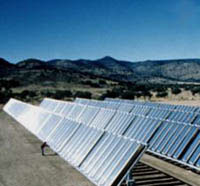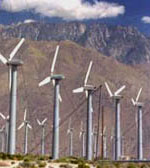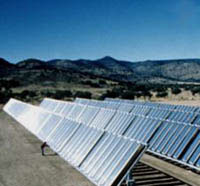For the burgeoning clean energy industry, these are heady times. Having spent most of its years in uphill struggle, the industry has now climbed to the takeoff point. Wind and solar are the world’s fastest growing energy sources, their costs rapidly curving down toward competitiveness with fossil fuels. Fuel cells that provide clean electricity for buildings and new-generation vehicles are nearing the market.

Making hay while the sun shines.
Photo: NREL/PIX.
With the right mix of public and private initiatives, clean energy could ramp up rapidly. Shell Oil planners see renewables potentially becoming cost-competitive with fossil fuels by 2020 and producing more than half the planet’s energy by 2050.
“I believe there will be a complete revolution in energy technology, which will enable us to turn around global warming,” President Clinton recently said. “I just hope it happens in time to avoid melting the polar ice cap, or some other disastrous thing.”
Time is of the essence. Presidential science advisor John Holdren notes that if power plants on the drawing boards now are constructed, they will still be in operation in 2050. “We are running out of time for a smooth transition to a sustainable energy future,” he says.
The 1990s were the warmest decade in at least 1,000 years, and 1998 was the hottest of those years. Now 1999 is going down in the books as the second-warmest year on land, and this past winter in the U.S. had the highest average temperature of any winter since the government began keeping records.
The growing body of evidence for climate change recently spurred the heads of the top climate monitoring organizations in the United States and Britain to break with any past scientific reticence and clearly connect global warming with human activities.
“Our climate is now changing rapidly … Our new data and understanding now point to a critical situation,” said U.S. National Oceanic and Atmospheric Administration chief James Baker and U.K. Meteorological Office head Peter Ewins in December 1999. “Ignoring climate change will surely be the most costly of all possible choices, for us and our children.”
“We’re now coming clean and saying we believe the evidence is almost incontrovertible, that man has an effect and therefore we need to act accordingly,” Ewins added.
While climate scientists have been moving toward that conclusion for some time, a similar finding by the World Economic Forum came as a shock. Hundreds of the world’s very top business and political leaders convening at the group’s annual meeting in Davos, Switzerland, in January 2000 selected climate change as the world’s most challenging problem.

The way the wind blows.
Photo: NREL/PIX.
A study by a group of 11 scientists published in Nature in October 1998 underscores the fact that averting catastrophe from global warming will be no small task. They concluded that holding carbon dioxide (CO2), the main greenhouse culprit, to its current concentration in the atmosphere will require production of 10 terawatts of non-fossil-fuel energy (one tarawatt is equal to 1 trillion watts) — the equivalent of two-thirds of current primary global energy production — by 2018. If producing that much carbon-free energy takes until 2035, CO2 will double from today’s already climate-disrupting level.
Added Martin Hoffert and his study coauthors, “market inefficiencies may preclude timely development of such technologies at the required scale … The past century, accelerated development from wartime and postwar research produced commercial aviation, radar, computer chips, lasers, and the Internet, among other things.” The need to stabilize the climate could require a crash program “pursued with the urgency of the Manhattan Project or the Apollo space program.”
Though the task is imposing, the clean energy revolution is coming along just in time, promising genuine climate solutions as well as phenomenal economic opportunities. Energy generated with clean sources such as sun, wind, and hydrogen at millions of points, all linked by information technology that manages both power production and consumption for peak efficiency — this is the picture of an emerging energy web that will parallel the Internet and in many ways be tied to it. It represents the most significant energy transformation since Edison set up the first power plant over a century ago.
We are at the portal of the clean energy revolution. Whether it takes off fast enough to restabilize the climate is an issue of global urgency, with long-term, irreversible implications. Required are gutsy entrepreneurs, visionary business leaders, and public leadership, not only at the federal level, but also from enlightened states and cities moving to protect the planet and seize a significant economic opportunity at the same time.


